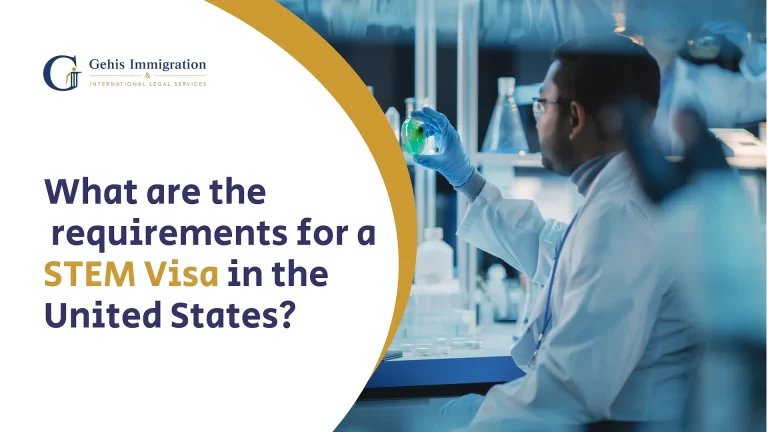The demand for qualified professionals in science, technology, engineering, and mathematics (STEM) has increased dramatically in an increasingly technologically advanced and interconnected world. Numerous nations, including the US, have instituted STEM visa initiatives to meet this demand and draw in highly skilled individuals worldwide. These initiatives aim to make it easier for foreign professionals with experience in STEM fields to enter the workforce.
A STEM visa is designed for individuals with qualifications and skills in science, technology, engineering, or mathematics. These visas are typically intended to support recruiting foreign talent in STEM fields to contribute to the innovation and development of the host country’s economy.
What Are The Types of STEM Visas?
H1B Visa:
The H-1B visa is a non-immigrant visa in the United States designed for foreign professionals working in specialized occupations, including many STEM fields.
The primary purpose of the H-1B visa is to allow U.S. employers to temporarily hire highly skilled foreign workers to fill positions for which there is a shortage of qualified American workers.
Eligibility Criteria for H1-B:
To be eligible for an H-1B visa, individuals must have a minimum of a bachelor’s degree or equivalent in a specific field related to the job.
The job for which the visa is sought must be in a specialty occupation requiring specialized knowledge and skills.
An employer in the U.S. must sponsor the H-1B visa for a specific employee.
The U.S. employer must file a petition on behalf of the foreign worker. This involves submitting documentation proving the job is a specialty occupation, and the applicant possesses the required qualifications.
Before filing the petition, the employer must obtain certification from the Department of Labor by filing an LCA. This document attests that the employment conditions are fair and meet prevailing wage standards.
The employer files Form I-129, the Petition for a Nonimmigrant Worker, with the U.S. Citizenship and Immigration Services (USCIS).
USCIS Approval: Upon USCIS approval, the foreign worker can apply for the H-1B visa at a U.S. consulate or embassy abroad.
There is an annual cap on the number of new H-1B visas issued, set at 65,000, with an additional 20,000 reserved for individuals with advanced degrees (master’s or higher) from U.S. institutions.
Due to the high demand for H-1B visas, a lottery system is often employed when the number of applications exceeds the available cap. The lottery is conducted randomly to select the petitions that will be processed further.
Certain employers, such as universities and research institutions, are exempt from the H-1B cap, as are individuals who have already been counted against the cap in the past.
The H-1B visa process can be complex, and both employers and foreign workers often seek legal advice to ensure compliance with regulations and increase the likelihood of a successful application. The H-1B visa is crucial for attracting and retaining skilled international talent in the U.S. workforce.
F-1 Optional Practical Training (OPT) STEM Visa Extension
F-1 Optional Practical Training (OPT) STEM Extension allows international students with F-1 visas who have completed a degree in a qualifying STEM field to work in the U.S. for an additional 24 months beyond the initial 12 months of standard OPT.
The STEM OPT extension provides 36 months of work authorization, combining the initial 12 months of standard OPT with the additional 24 months of the STEM extension.
Eligibility Requirements for F-1 Visa:
To be eligible for the STEM OPT extension, the student must have earned a degree in a STEM field included in the U.S. government’s official STEM Designated Degree Program List.
The student must be in a valid period of post-completion OPT and working for or actively seeking employment with an employer enrolled in the E-Verify program.
The employment must be directly related to the student’s degree and involve at least 20 hours per week. The employer must be enrolled in E-Verify and agree to certain reporting obligations.
The student must file Form Application for Employment Authorization with the U.S. Citizenship and Immigration Services (USCIS). This application is typically submitted within 90 days before the expiration of the standard OPT authorization.
The student’s designated school official (DSO) must provide a new Form I-20 with the updated STEM OPT recommendation, including the correct STEM Designated Degree Program Code.
The student and employer must develop and submit a formal Training Plan on Form I-983, detailing how the STEM OPT employment is directly related to the student’s degree and how it meets regulatory requirements.
STEM OPT participants must regularly report to their Designated School Official (DSO) regarding changes in employment status, address, or other relevant details.
Employers must submit regular validation reports to the student’s DSO, confirming that the student is engaged in practical training and that the information provided in the Form Training Plan is accurate.
The U.S. government may conduct site visits to verify the STEM OPT program’s integrity, including the accuracy of information provided in the Training Plan and compliance with program requirements.
O-1 Visa for Extraordinary Ability in Sciences
The O-1 visa is reserved for individuals with extraordinary ability or achievement in their field, including the sciences. The criteria for extraordinary ability are high, and applicants must demonstrate a level of expertise and recognition significantly above that ordinarily encountered.
For sciences, this may include a record of sustained acclaim and recognition in the form of major scientific awards, significant contributions to the field, scholarly publications, or other evidence of exceptional expertise.
The applicant must showcase a sustained national or international reputation for excellence in their scientific endeavors.
This may include awards, recognitions, memberships in prestigious scientific organizations, or any other documentation demonstrating a high level of achievement in the field of science.
Letters from experts in the field, colleagues, or organizations attest to the applicant’s extraordinary ability and the significance of their contributions.
Copies of published articles, papers, or any other scholarly work that highlights the applicant’s contributions to the sciences.
If applicable, contracts or agreements with employers or organizations in the U.S. that confirm the applicant’s engagement in work related to their extraordinary ability.
A detailed itinerary outlining the nature of the work or events the applicant will be involved in during their stay in the U.S.
The U.S. employer or agent files Form Petition for a Nonimmigrant Worker on behalf of the O-1 visa applicant.
The application must accompany supporting documentation demonstrating the applicant’s extraordinary scientific ability.
Once the petition is approved by the U.S. Citizenship and Immigration Services (USCIS), the applicant can apply for the O-1 visa at a U.S. consulate or embassy abroad.
The O-1 visa focuses on individuals with extraordinary abilities, setting it apart from other STEM visas that often emphasize educational qualifications and specialized skills.
Unlike some STEM visas that require a minimum level of education, the O-1 visa does not have a specific educational threshold. Instead, it emphasizes the applicant’s exceptional achievements and recognition in their field.
The criteria for the O-1 visa are highly individualized, focusing on the applicant’s unique contributions to their field. This contrasts with other STEM visas that may have standardized educational or employment criteria.
The O-1 visa can be sponsored by a U.S. employer or filed as a self-petition by the individual, providing flexibility in the application process.
Final Word
To enter the United States, STEM professionals must understand several visa categories, each with its requirements. Important factors to consider are school credentials, employer sponsorship, legal compliance, and proving that specialized skills are required. Employers and foreign professionals must meet strict requirements to contribute to and benefit from the U.S. STEM landscape, ranging from the H-1B visa to the F-1 OPT STEM extension and the O-1 visa for extraordinary ability.
As the world becomes more interconnected, the role of STEM professionals in driving innovation and economic growth is expected to grow, making immigration policies and practices in this realm critical for fostering a dynamic and competitive workforce.
The intersection of immigration and STEM is a dynamic field that will continue to shape the future of global talent mobility and innovation. Staying informed about evolving policies and trends will be crucial for professionals seeking opportunities and employers aiming to build a skilled and diverse workforce in the ever-evolving STEM sector.






